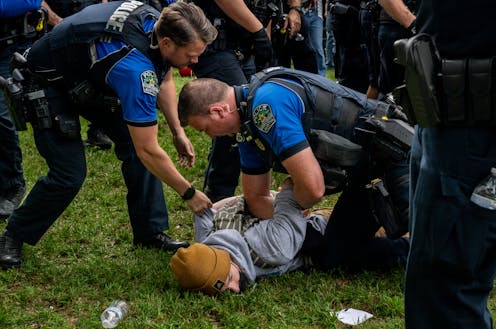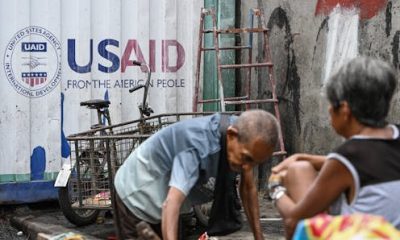
A student is arrested during a pro-Palestinian demonstration at the University of Texas at Austin on April 24, 2024. Brandon Bell/Getty Images
Interrogations of university leaders spearheaded by conservative congressional representatives. Calls from right-wing senators for troops to intervene in campus demonstrations. Hundreds of student and faculty arrests, with nonviolent dissenters thrown to the ground, tear-gassed and tased.
We’ve been here before. In my book “Resistance from the Right: Conservatives and the Campus Wars in Modern America,” I detail how, throughout the 1960s and into the 1970s, conservative activists led a counterattack against campus antiwar and civil rights demonstrators by demanding action from college presidents and police.
They made a number of familiar claims about student protesters: They were at once coddled elitists, out-of-state agitators and violent communists who sowed discord to destroy America. Conservatives claimed that the protests interfered with the course of university activities and that administrators had a duty to guarantee daily operations paid for by tuition.
Back then, college presidents routinely caved to the demands of conservative legislators, angry taxpayers and other wellsprings of anticommunist outrage against students striking for peace and civil rights.
Today, university leaders are twisting themselves in knots to appease angry donors and legislators. But when Columbia University President Minouche Shafik called in the NYPD to quell protests, she was met with a firm rebuke from the American Association of University Professors.
If the past is any indication, the road ahead won’t be any easier for college presidents like Shafik.
Lawfare from the right
Throughout the 1960s, students organized a host of peace and civil rights protests, which conservatives characterized as communist.
Students spoke out against American involvement in the Vietnam War, the draft and compulsory ROTC participation. They demanded civil rights protections and racially representative curricula. The intervention of police and the National Guard often escalated what were peaceful protests into violent riots and total campus shutdowns.
From 1968 into the 1970s, conservative lawyers coordinated a national campaign to sue “indecisive and gutless” college presidents and trustees whose approach to campus demonstrations was, in conservatives’ estimation, too lenient.
The right-wing organization Young Americans for Freedom hit 32 colleges with lawsuits, including private Ivy League schools like Columbia, Harvard and Princeton, as well as public land-grant universities like Michigan State and the University of Wisconsin.
The legal claim was for breach of contract: that presidents were failing to follow through on their end of the tuition agreement by not keeping campuses open and breaking up the protests. Young Americans for Freedom sought to set legal precedent for students, parents and broadly defined “taxpayers” to be able to compel private and public institutions to remain open.
Conservative students further demanded that their supposedly communist peers be expelled indefinitely, arrested for trespassing and prosecuted.
Expulsions, of course, carried implications for the draft during these years. A running joke among right-wing activists and politicians was that protesters should be given a “McNamara Scholarship” to Hanoi, referencing Robert McNamara, the U.S. secretary of defense and an architect of the Vietnam War.
A pro-Vietnam War pin suggests dumping protesters in North Vietnam’s capital, Hanoi.
Stuart Lutz/Gado/Getty Images
Meanwhile, right-wing activists hounded college leaders with public pressure campaigns by collecting signatures from students and alumni that called on them to put an end to campus demonstrations. Conservatives also urged donors to withhold financial support until administrators subdued protesting students.
Cops on campus
Following the massacre at Kent State in 1970, when the National Guard fired at students, killing four and wounding nine, nearly half of all colleges shut down temporarily amid a wave of nationwide youth outrage. With only a week or two left of the semester, many colleges canceled remaining classes and even some commencement ceremonies.
In response, conservatives launched a new wave of post-Kent State injunctions against those universities to force them back open.
With protests ongoing – and continued calls from the right to crack down on them – many university administrators resorted to calling on the police and the National Guard, working with them to remove student protesters from campus.
In fact, this very moment brought about the birth of the modern campus police force.
Administrators and lawmakers, afraid that local police could not handle the sheer number of student demonstrators, arranged to deputize campus police – who had historically been parking guards and residence hall curfew enforcers – with the authority to make arrests and carry firearms.
State and federal lawmakers attempted to further stifle student dissent with reams of legislation. In 1969, legislators in seven states passed laws to punish student activists who had been arrested during protests through the revocation of financial aid, expulsion and jail sentences.
President Richard Nixon, who had excoriated campus disruptions during his successful White House run in 1968, encouraged college presidents to heed the laws and applauded them for following through with expulsions.
Is ‘antisemitism’ the new ‘communism’?
As the U.S. presidential election approaches, I’ll be watching to see how the Trump and Biden campaigns respond to ongoing student protests.
For now, Trump has called the recent protests “antisemitic” and “far worse” than the 2017 white nationalist rally in Charlottesville. Biden has similarly condemned “the antisemitic protests” and “those who don’t understand what’s going on with the Palestinians.”
Both are repeating the false framework laid out by GOP Reps. Elise Stefanik and Virginia Foxx, a trap that university administrators have fallen into during House inquiries since Hamas’ Oct. 7, 2023, attack on Israel.
There indeed have been antisemitic incidents associated with pro-Palestinian demonstrations on university campuses.
But in these hearings, Stefanik and Foxx have baited four women presidents into affirming the right’s politicized framing of the protests as rife with antisemitism, leading the public to believe that isolated incidents are instead representative and rampant.
Like their association of civil rights and peace demonstrators with communism throughout the Cold War, politicians on both sides of the aisle are now broadly hurling claims of antisemitism against anyone protesting Israel’s war in Gaza, many of whom are Jewish.
The purpose then, as it is now, is to intimidate administrators into a false political choice: Will they protect students’ right to demonstrate or be seen as acquiescent to antisemitism?
A counter-protester holds a sign during an anti-Vietnam War event in New York City in 1969.
Harvey L. Silver/Corbis via Getty Images
Lauren Lassabe Shepherd does not work for, consult, own shares in or receive funding from any company or organization that would benefit from this article, and has disclosed no relevant affiliations beyond their academic appointment.
Advertisement

Advertisement
Contact Us
If you would like to place dofollow backlinks in our website or paid content reach out to info@qhubonews.com











